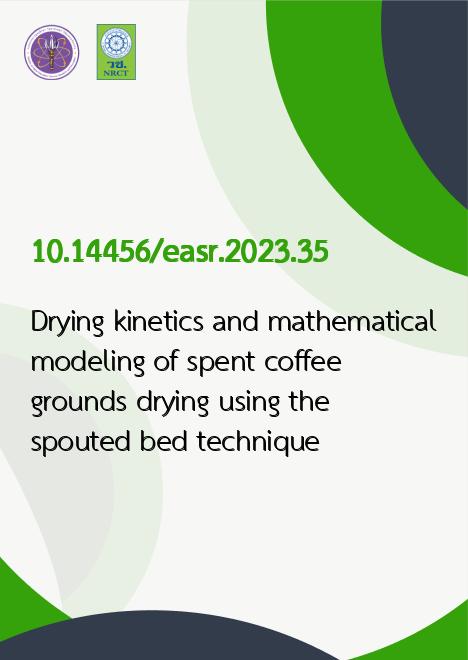
|
Drying kinetics and mathematical modeling of spent coffee grounds drying using the spouted bed technique |
|---|---|
| รหัสดีโอไอ | |
| Creator | Poomjai Sa-adchom |
| Title | Drying kinetics and mathematical modeling of spent coffee grounds drying using the spouted bed technique |
| Publisher | Faculty of Engineering, Khon Kaen University |
| Publication Year | 2566 |
| Journal Title | Engineering and Applied Science Research |
| Journal Vol. | 50 |
| Journal No. | 4 |
| Page no. | 324-334 |
| Keyword | Drying kinetics, Mathematical modeling, Spent coffee grounds drying, Spouted bed technique |
| URL Website | https://ph01.tci-thaijo.org/index.php/easr/index |
| Website title | Engineering and Applied Science Research |
| ISSN | 2539-6161 |
| Abstract | The objective of this study was to investigate the drying kinetics of spent coffee grounds (SCGs) using spouted bed drying, with inlet air temperatures of 60, 75, and 90°C, and SCGs masses of 0.5 and 1 kg. The study also examined the specific energy consumption (SEC) and the color of the dried SCGs. To estimate the moisture ratio as a function of drying time, twelve mathematical drying models were used to fit the experimental data. In the experiments, the SCGs with an initial moisture content of approximately 52% w.b. were dried using the spouted bed technique until the final moisture content was less than 7% w.b. The experimental results found that as the inlet air temperature was increased, the moisture content of the SCGs and the SEC decreased. An increase in the mass of the SCGs resulted in a decrease in its moisture content but an increase in the SEC. Additionally, an increase in the inlet air temperature and the mass of the SCGs caused a decrease in the L* value but an increase in the a* and b* values. Regression analysis revealed that, among the twelve models tested, the Midilli et al. model was the most suitable for describing the drying behavior of SCGs during spouted bed drying. The average values of coefficient of determination (R2), root mean square error (RMSE), and reduced chi-square (χ2) of the Midilli et al. model under the spouted bed drying were 0.999602, 0.000468 and 0.00000201 for a mass of SCGs at 0.5 kg, and 0.999553, 0.000961 and 0.00000087 for a mass of SCGs at 1 kg, respectively. |